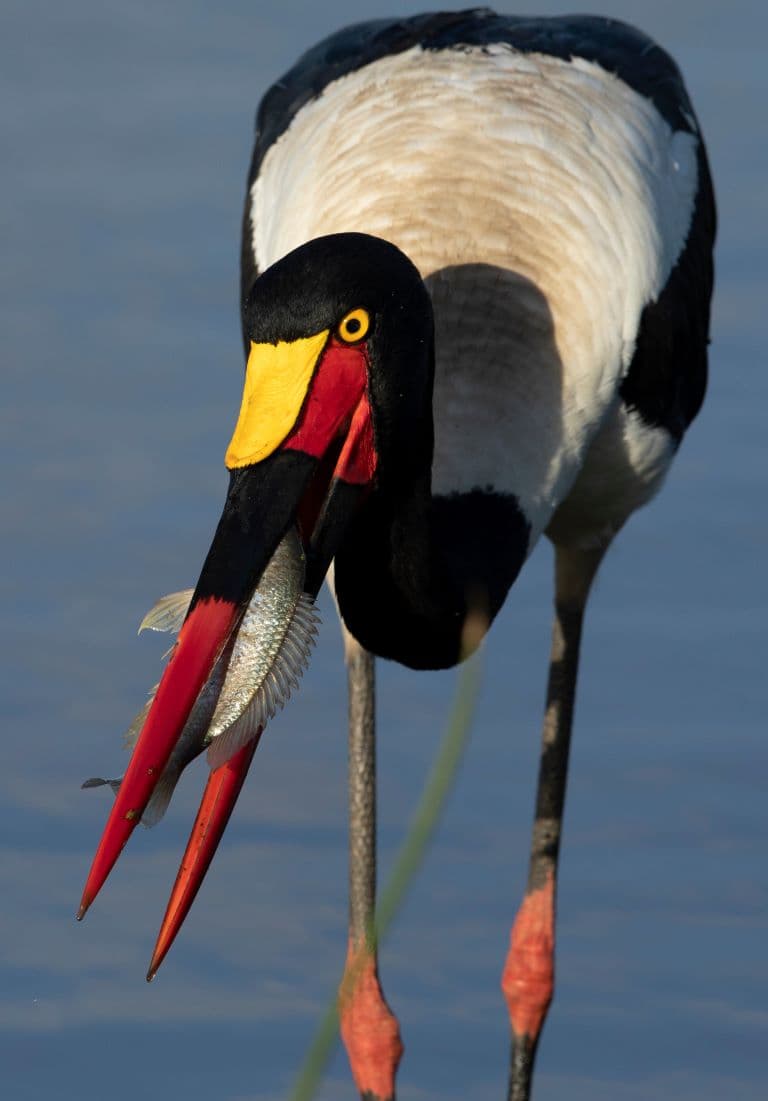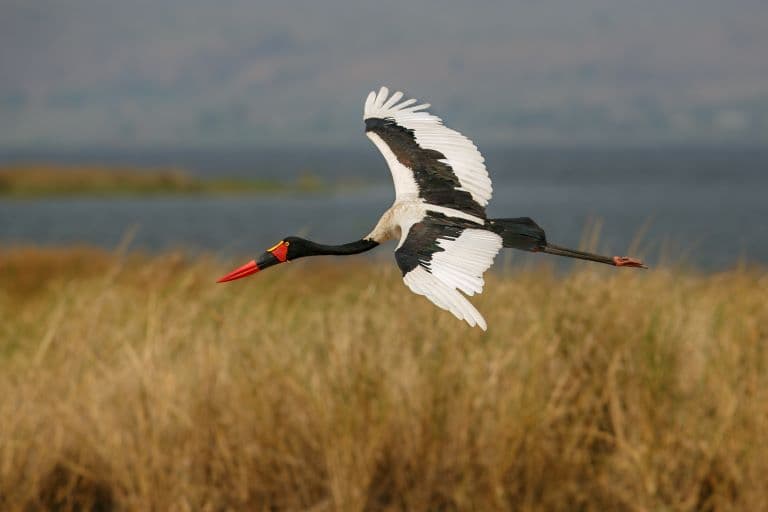Saddle-billed Stork Profile
Uganda missed a trick when picking its national bird. The crested crane is great and all, but there’s another long-legged Avian that literally wears the colours of the Ugandan flag on its face.
Ugandans aren’t known for their subtlety, but even this was perhaps a little too on the nose.
The saddle-billed stork is still a fine runner-up, and its size and beauty make it a great candidate for any of the other Sub-Saharan African countries it inhabits.

Saddle-billed Stork Facts Overview
| Habitat: | Forested wetlands, flood plains |
| Location: | Widespread across Sub-Saharan Africa. |
| Lifespan: | 12 years |
| Size: | Up to 1.8m (5 ft 11 in) tall, 2.7 m (8 ft 10 in) wingspan |
| Weight: | Up to 7.5 kg |
| Colour: | Iridescent black head, neck, wings; white elsewhere; red, yellow, black beak |
| Diet: | Mostly fish, also amphibians, small mammals, insects, birds, reptiles |
| Predators: | Eggs can be eaten by most predators, but adults have few to none. |
| Top Speed: | Unknown |
| No. of Species: | 1 |
| Conservation Status: | Least Concern (IUCN) |
The saddle-billed stork is one of the easiest birds in the world to identify. For one thing, they’re absolutely enormous, but on top of that, they’ve got vibrant black, yellow and red colouration on their long, curved beaks and striking black-and-white plumage.
Despite sharing a range with other monster storks like the Maribou, their closest relative is an Asian species, and this shows up in the similarities the two share, like an ominous silence and solitary lifestyle.
While they’re no longer present in Egypt, hieroglyphs show they were once revered there in ancient times.
Interesting Saddle-billed Stork Facts
1. They have an Asian cousin
The black-necked stork from Asia is a very handsome bird that was originally placed in the Mycteria genus, along with a whole bunch of cool storks found all over the world.
But some smart fella by the name of Marvin Philip Kahl, who just happens to be a leading stork expert, spotted similarities in its behaviour to a lone species in the genus Ephippiorhynchus.
This incredible observation was later backed up with DNA evidence, and the two species were finally married in the eyes of science.
Interestingly, they share one other clue to their relationship that Kahl apparently overlooked: they are both the only storks in which the male’s iris is a different colour from the female’s.
This genus name is derived from the Ancient Greek ephippos, which means “Something which is placed on a horse”, and rhynchus, which means “bill”. And with the addition of the black-necked stork, the saddle-bill gained its first and only cousin. 1
2. They’re huge
Storks are big birds, but the saddle-billed stork really stretches things. They stand at 1.5 metres in height and when mediating an argument can keep either party 2.7 metres from each other without breaking contact.
Males are the larger of the sexes, at up to 7.5 kg, and they are also distinguished by their brown eyes and yellow wattles. Females have yellow eyes and no wattles.

3. They’re quiet
These are gorgeous birds and they don’t make a fuss about it. For the vast majority of their time on Earth, they remain silent and stoic, but when they get excited around the nest they engage in a lovely display of bill slapping and clattering.
These storks don’t have the hardware in their throats to produce any meaningful song or call, and this might be why they are thought to be the basis for the very exciting legend of the kongamato; a forgotten Pterosaur that torments fisherment in the congo.
When seen from a distance, in flight, this huge bird could potentially be mistaken for a silent, prehistoric reptile. 2
4. They’ll eat everybody
Storks are traditionally thought of as the way babies are made.
This myth doesn’t hold up to scrutiny in a number of ways, but perhaps most glaring is the fact that a stork would much more likely eat a baby than dutifully carry one in through the window of a crying circus elephant, or that of any other morbidly expectant mother.
Storks are very good-looking animals but their beauty belies their lack of dietary rigour and their ferocity as predators.
The saddlebill, for example, loves to eat lungfish, which is fine, but they will happily swallow frogs, snails, mammals, baby birds, adult birds, mongooses and at least one red-billed duck. They have even been seen trying to eat a mongoose.
Saddle-billed storks are formidable predators and will use a combination of visual cues and simply feeling around in the mud with their beaks to find prey items. 3
5. They’re mostly solitary
This species isn’t entirely sedentary and will move between habitats to find their optimal feeding grounds. But they don’t truly migrate, and while they can be found in flocks, they aren’t really interested in one another outside of the context of safety.
Pairs will breed without help from outside, and males will be heavily involved in the rearing of the young. They can be found in family groups of up to 12 individuals, but often times they’re quite content by themselves. 4

6. They meant a lot to the Ancient Egyptians
Nowadays, there are no saddle-back storks in Egypt. Their range begins farther south, in wetter habitats. But this wasn’t always the case, and Ancient hieroglyphs show us that they were not only present but revered in Egypt, thousands of years ago.
This species has its own depiction in Egyptian texts, appearing as the symbol bꜣ, which is said to represent everything that makes an individual unique.
This early concept of personality was thought of by the Egyptians to last after death and the presence of the stork as its mascot says something about how valued these birds likely would have been to associate it with one of the most powerful and important concepts in Egyptian culture of the time.

Saddle-billed Stork Fact-File Summary
Scientific Classification
| Kingdom: | Animalia |
| Phylum: | Chordata |
| Class: | Aves |
| Order: | Ciconiiformes |
| Family: | Ciconiidae |
| Genus: | Ephippiorhynchus |
| Species: | senegalensis |
Fact Sources & References
- D. Scott Wood (1984), “Concordance between classifications of the Ciconiidae based on behavioral and morphological data”, Springer Nature Link.
- Houston Zoo (2009), “Lily the Saddle Billed Stork”, YouTube.
- “Saddle-billed Stork”, Cornell Lab.
- “Saddle-billed Stork”, IUCN Red List.
